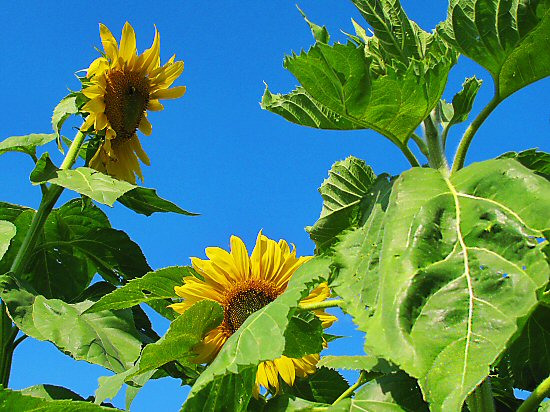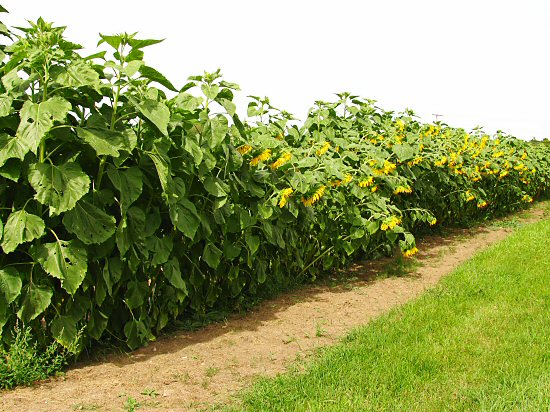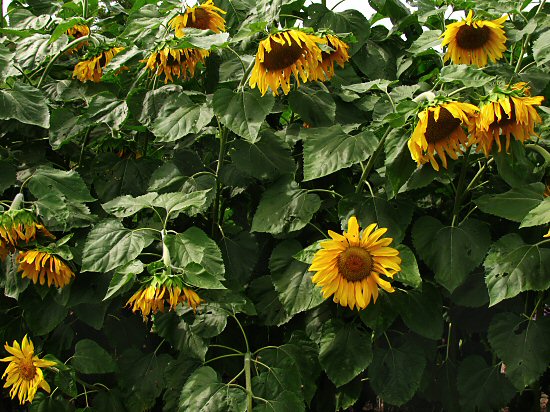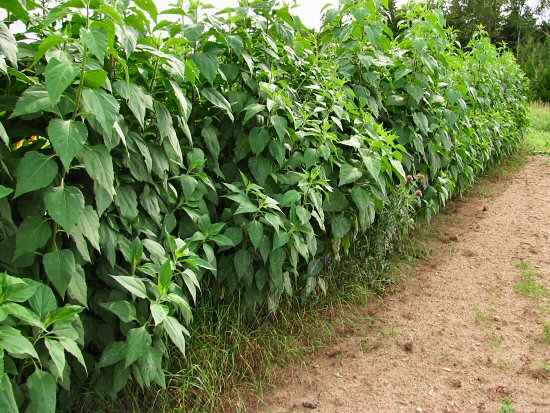
There are pretty ornamental cutting sunflowers, and then there are these monsters of the field, towering Early Russians, and their almost as imposing kin, the rugged Jerusalem artichoke (last photo). They’re the genus Helianthus, North American natives, supposedly dating back 8,000 years, and by the look of it, really not too disturbed by the crazy weather right now.
Both of these are experiments. This is the second season for the Russian giants, grown exclusively for their potential as a plant-protecting wall. It’s the third time around for the JAs, a crop that can do double duty as a living wall… Neither were strategically placed for action this year, but the idea is mainly to use them as shade during scorching summers. They get to a pretty good height by sometime in July, so the timing works. Even at 7-8′, they won’t protect too far out, a dense and high-value crop like all-lettuce mesclun would make it worthwhile. They could be good as windbreaks as well, but I haven’t considered for what…

The sunflowers are around 8′ tall now, it’s quite incredible (with a longer season, they can apparently get up to 14′). You’d think with them growing so fast and big, they’d always stand out, but with all that’s going on in the field, you can forget and then one day, turn around and BAM, there’s that wall o’ green, STARING at you…

The flowers are practically as big as my head, and so heavy, they eventually wind up completely face down.

The Jerusalem artichoke are a little more refined, but still big and resilient. They’re around 7′. Both sunflowers and JAs are planted in double rows, and held up to this year’s helping of storms and massive winds no problem. Reliable…




I’ve also thought the JA’s would make a nice quick windbreak, but they’re only effective mid to late summer. I found at my old place I had a lot of western exposure and the spring winds were rough. I’m interested in finding a quick fix for a spring windbreak. I’ve seen people pile large square bales of hay or straw in what looks like a windbreak. It would be expensive if it wasn’t your own hay I think.
Of course the long-term approach would be permanent tree windbreaks. Do you have plans for this, Mike?
Chris
I cannot think of a lovelier wall! Fabulous…Kim
you have really pulled this together in such a short while on the new land. congratulations with season one – bravo to all!
Not directly related this, but I’m looking for some advice. I’ve just acquired 2.5 acres of pasture with our new house in Cornwall, SW England. Our intention is to grow veg and feed 4 of us next year, then potentially develop a market garden. The land has had cattle on over the summer and previous summers, and has just been mown. I had big grand visions of using the fall to maximise soil fertility before major planting in Spring. Should I (a) have someone plough, till in horse manure, then sow a green manure to be turned under before planting, (b) have a couple of pigs go to work on the land, ploughing and manuring as they go or (c) leave it grass over fall / winter, then till it over a few times before I plant?
Any advice much appreciated. We like your blog by the way, have a look at ours:
I live in Ontario, Canada, and looking for JA seed. Does anybody have any advice?
Great idea on the sunflower windbreak. I grew a few last year and was amazed at the strength of the posts and how woodlike they were. I am thinking they could be used like bamboo for us cold weather gardeners.
I am planning on adding JA’s this coming spring.
Chris: The only tree-like plan I’ve had so far is for bamboo. We almost ordered some this spring, but ran out of time. It’s apparently a 3-year thing, I was told: sleep-creep-leap is how it goes, year 1-3.
Kim: Yeah, they’re pretty satisfying. Up to 8′ tall!!!
shellywoman: I don’t really notice, but several people who’ve come by and who work here have kinda pointed that out here and there, so when I do think about it for a moment, I guess it’s pretty cool! Like, an accomplishment of sorts. I’m happy it worked out… :)
ben: You also posted this in Tiny Farm Forum. Someone just replied there…!
chris: I got my original planting stock a couple of years ago from Hope Seeds in New Brunswick, and I found one or two other places by searching online. Once you get a few plants going, you’ll have a ton of planting stock to go forward, but it’s kinda hard to find. Does anyone around you have any? If you’re really stuck, I guess you could get some from me. I haven’t started digging ’em or even taken a look, but they should be fine. And since we’re certified, they’d be certified organic. :) Shoot me an email as a last resort!
Rick: Yeah, they’re pretty strong. After a touch of frost a couple days ago, the leaf cover has thinned a lot, and with those heavy heads packed with seed weighing them down, they’re starting to lean quite a bit, but as a wind-shade wall, they’ve already done their job!
Wow … that’s either brave or fool hearty. JA’s are one GIGANTIC pest. How do you expect to control them once they get established? I can only think of a few things that are harder to eradicate. They will spread everywhere.
Good luck.
I have a crazy addiction to Sunflower seeds so seeing that patch of sunflowers makes me drool! Very nice looking!
Paul: What makes chokes potentially “invasive” is also what makes ’em such a cool crop: they grow fast and don’t seem to be bothered by anything, weather or pests, above ground or below. At least, that’s been my experience in so far. The trick is to harvest them every year. I treat them like garlic, dig ’em up completely, reserve some seed stock, and plant it again as soon as I can in spring. I started doing that because I originally read that the tubers get increasingly gnarly if you keep growing them in one place, not as easy to harvest or divide up. Plus, I like moving things around. Maybe they’re more aggressive in warmer climates, but I can’t imagine a few pieces that got away ever starting their own rebel invasion… Not in a working market garden!!
Zone 9: I don’t think the seeds from this variety are too meaty, I vaguely remember checking last year, but there are a LOT of them (I’ll check again this time). The flowerheads are HEAVY, must weigh at least 3 lbs. Maybe…5!
Wow- this is a serious crop! Don’t sunflowers have a beneficial relationship with other plants for permaculture? I could be wrong….
My chickens LOVE sunflower LEAVES almost more than the seeds. My sunflowers year before last were all nude as high as a healthy hen can jump!
Good idea on the sunflower windbreak. I grew a few last year and was amazed at the strength of the posts and how woodlike they were. I am thinking they could be used like bamboo for us cold weather gardeners.
I am planning on adding JA’s this coming spring.
What kind of spacing did you go for with the sunflowers? Or was it more a broadcast the seed and let them sort it out job?
Kaarina: I haven’t companion planted sunflowers with anything, but apparently they’re beneficial to corn and squash…
Robert: We seeded them by hand, around 3″ apart in-row, got near 100% germination, and didn’t thin. Recommended spacing for giant sunflowers is from 6-8″ to 3′-4′, depending on where you look.
Very good and interesting !
We have sunflowers as well and I always find them interesting and beautiful. Though they don’t give off a beautiful scent just like other flowers, but it is surprisingly beautiful in it’s own way.
The soil in your location should drain well. Standing water is not good as is a place that does not get adequate rain, like directly next to your house under the eaves.
Thanks for sharing..nice collection..